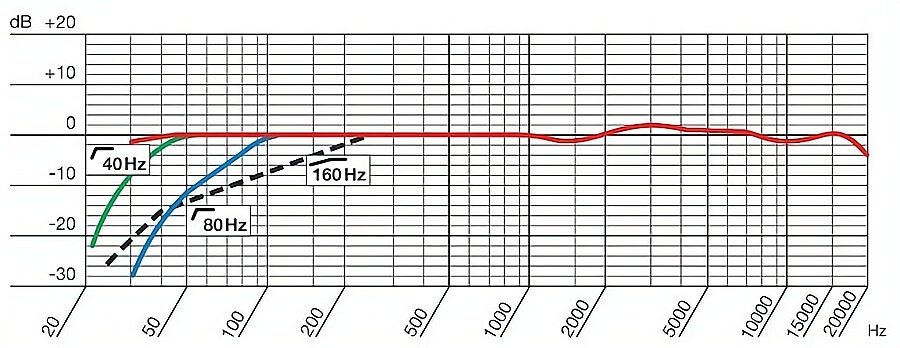Um das richtige Mikrofon mit einem angemessenen Frequenzgang auszuwählen, müssen Sie einige wichtige Aspekte kennen:
- Welche Tonquelle werden Sie aufnehmen?
- Wie sieht die Aufnahmeumgebung aus?
- Was ist die Aufzeichnungsmethode?.
Sehen wir uns einige Beispiele an:
1. Frequenzgang für Voice-Over-Aufnahmen

Voice-over-Aufnahmen werden in der Regel in einer kontrollierten Studioumgebung mit minimalen Geräuschen und Schallreflexionen durchgeführt. Unter solchen idealen Bedingungen ist ein Mikrofon mit einem flachen Frequenzgang die beste Wahl für die Aufnahme von natürlichem und präzisem Gesang.
Hauptmerkmale eines geeigneten Frequenzgangs für Voice-Overs:
- Kugel-, Nieren- oder Figur-8-Muster: Je nach Konfiguration können diese Richtcharakteristiken Sprache effektiv erfassen und gleichzeitig die Umgebungsakustik steuern.
- Low-End Roll-Off: Leichte Dämpfung der tiefen Frequenzen hilft, Geräusche wie Rumpeln oder Vibrationen zu eliminieren.
- Anhebung der hohen Frequenzen (6 kHz bis 12 kHz): Eine bescheidene Anhebung von 2-3 dB in diesem Bereich verleiht der Aufnahme Helligkeit und Klarheit und verstärkt die stimmliche Präsenz.
2. Frequenzgang für Live-Gesangsdarbietungen

Live-Auftritte finden oft auf lauten Bühnen mit anderen Instrumenten, Publikumslärm und Raumhall statt. Hier werden Mikrofone mit Nieren-Richtcharakteristik bevorzugt, da sie sich auf den Klang direkt vor dem Mikrofon konzentrieren und unerwünschte Geräusche zurückhalten. Außerdem werden diese Mikrofone oft in der Nähe des Sängers positioniert, was zu einem Nahbesprechungseffekt führen kann, der die tiefen Frequenzen verstärkt.
Hauptmerkmale des geeigneten Frequenzgangs für Live-Gesang:
- Low-End Roll-Off: Reduziert Bühnenvibrationen und Netzbrummgeräusche.
- Flacher Frequenzgang von 100 Hz bis 2 kHz: Erfasst den zentralen Stimmbereich mit Präzision.
- Anhebung von 3 kHz bis 10 kHz: Verbessert die Klarheit der Stimme und hilft ihr, sich im Mix durchzusetzen.
3. Frequenzgang für Snare-Drum-Aufnahmen

Eine Snare Drum hat typischerweise starke Grundfrequenzen im Bereich von 100 Hz bis 250 Hz, mit einem zusätzlichen Peak zwischen 3 kHz und 6 kHz für ihren oberen harmonischen Charakter. Snare Drums werden in der Regel mit speziellen Mikrofonen aufgenommen, um ihren einzigartigen Klang zu betonen und sie gleichzeitig von anderen Schlagzeugelementen zu isolieren.
Hauptmerkmale des geeigneten Frequenzgangs für Snare Drums:
- Low-End Roll-Off: Filtert tieffrequente Geräusche von anderen Trommelkomponenten heraus.
- Mid-High Boost: Verstärkt die rhythmische Wirkung und die klanglichen Eigenschaften der Snare.
- Dämpfung der hohen Frequenzen: Reduziert Störungen durch Becken und andere High-End-Elemente.
4. Frequenzgang für Klavieraufnahmen

Klaviere haben einen breiten Frequenzbereich und werden am besten mit Mikrofonen aufgenommen, die einen flachen und erweiterten Frequenzgang haben. In einer Aufnahmesituation, wie z. B. einem Konzertsaal, sind der natürliche Hall und die Akustik des Raums entscheidend für einen authentischen Klavierklang. Mikrofone mit Kugelcharakteristik liefern in solchen Situationen oft die natürlichsten Ergebnisse.
Hauptmerkmale eines geeigneten Frequenzgangs für Klaviere:
- Flacher Frequenzgang: Stellt sicher, dass der gesamte Klangbereich des Klaviers originalgetreu wiedergegeben wird.
- Großer Dynamikbereich: Erfasst sowohl die weichen Nuancen als auch die kräftigen Töne des Instruments.
- Präzise Klangreflektionen: Reflektiert die Akustik des Aufnahmeraums für ein lebensechtes Gefühl.
Die Wahl des richtigen Mikrofons mit einem geeigneten Frequenzgang hängt von den Eigenschaften der Schallquelle, der Umgebung und der Aufnahmemethode ab. Ganz gleich, ob Sie Gesang, Instrumente oder ganze Ensembles aufnehmen - wenn Sie auf den Frequenzgang achten, erzielen Sie die beste Audioqualität für Ihre speziellen Anforderungen.


